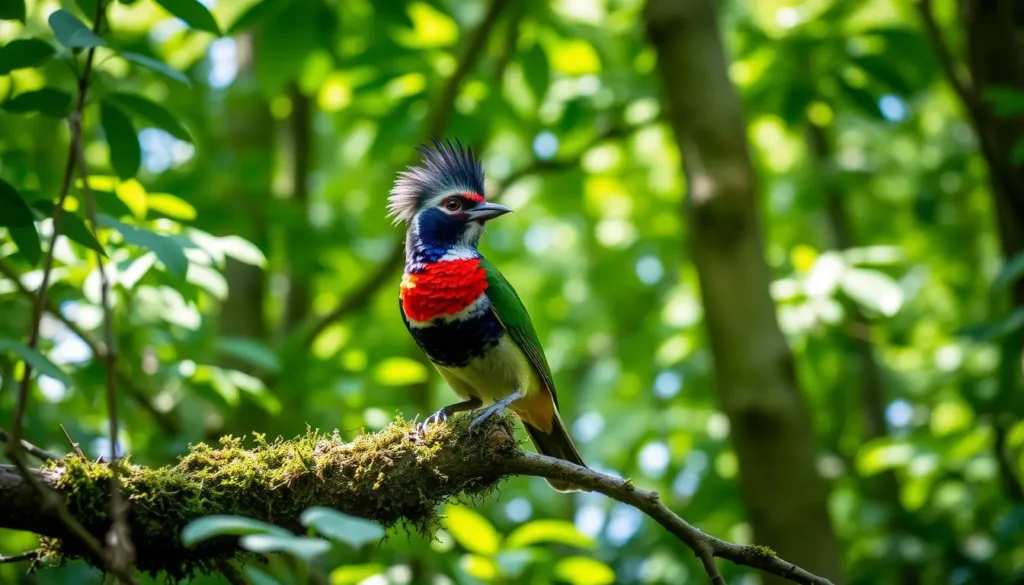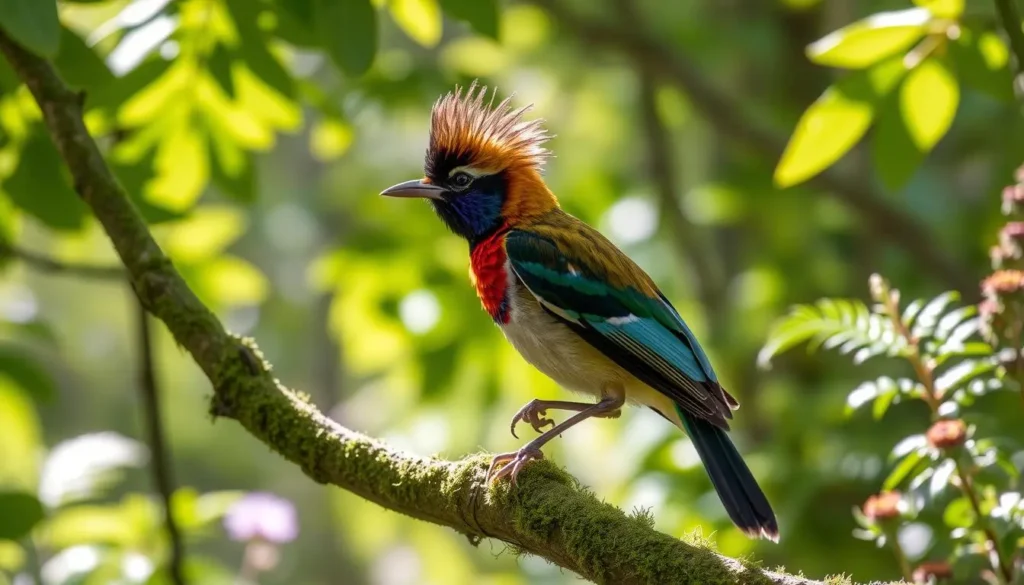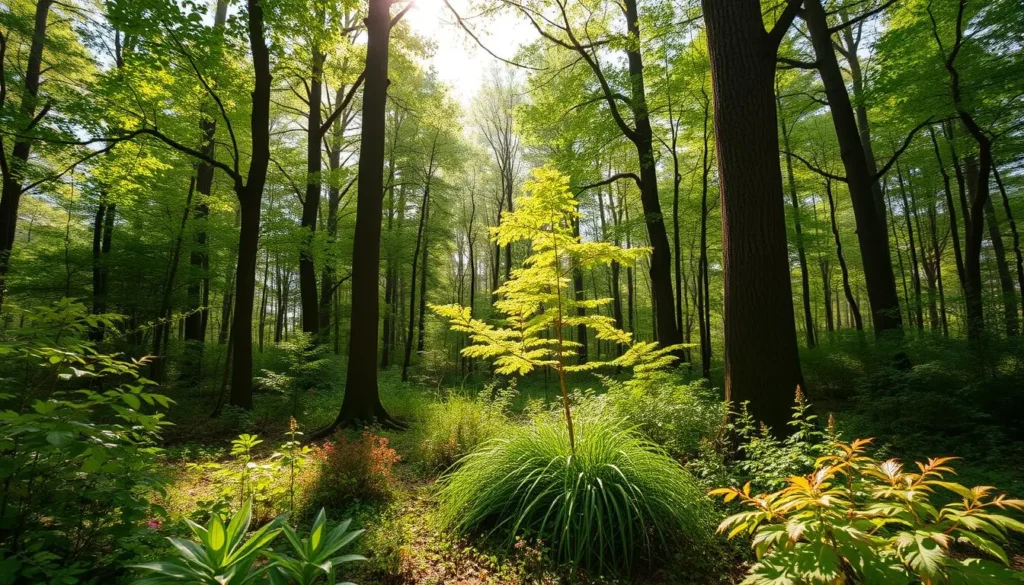Table of Contents
The Crested Woodland Bird, recently featured in the New York Times (NYT) crossword, is not just a puzzle answer, but a captivating figure in the world of avian wonders. Nestled within nature’s intricate tapestry, these birds boast distinctive features and unique behaviors that set them apart. From their mesmerizing courtship displays to the vital role they play in maintaining the delicate balance of ecosystems, the Crested Woodland Bird is truly one of nature’s best-kept secrets. This blog explores everything from where to find them, how to identify them, and their cultural significance to the challenges they face in the wild.

Key Takeaways
- The crested woodland bird is a captivating avian species often featured in the New York Times crossword puzzle.
- This enigmatic creature is a true gem of the natural world, with distinctive plumage and fascinating behaviors.
- The presence of the crested woodland bird in the NYT crossword underscores its significance as a symbol of the natural world’s diversity and resilience.
- Birdwatchers and naturalists alike are drawn to the crested tit‘s intriguing characteristics and role in the forest ecosystem.
- Understanding the crested woodland bird’s habitat, range, and conservation efforts is crucial for appreciating this unique avian species.
Unveiling the Crested Woodland Bird’s Enigmatic Allure
The crested woodland bird is a captivating sight for nature lovers and birdwatchers. It has a striking crest on its head, making it a standout in the woodland. Its unique features make it a subject of fascination and study.
A Captivating Avian Presence in Nature’s Tapestry
The crested woodland bird’s appearance is truly eye-catching in its natural habitat. Its vibrant plumage, a mix of rich browns and grays, stands out against the green foliage. The bird’s crest adds an air of elegance, changing with its mood or behavior.
Distinctive Features that Set This Bird Apart
- Striking crest: The crested woodland bird’s most distinctive feature is its prominent crest, which can be raised or lowered to express various emotions and behaviors.
- Vibrant plumage: The bird’s plumage is a captivating blend of rich browns, grays, and subtle hints of other colors, creating a visually stunning appearance.
- Agile and elusive: Despite its bold coloration, the crested woodland bird is known for its agility and ability to move swiftly through the dense foliage, making it a challenge to spot.
The crested woodland bird’s unique characteristics and intriguing behavior fascinate many. Its presence in the woodland ecosystem shows the natural world’s incredible diversity.

The Crested Woodland Bird’s Fascinating Habitat and Range
The crested woodland bird is a captivating avian species. It thrives in the lush, verdant habitats of forests and woodlands across various regions. These birds have adapted remarkably well to their natural environment.
One of the key characteristics that sets the crested woodland bird apart is its preference for specific types of woodland habitats.
These birds are commonly spotted in well-established deciduous and mixed forests. The canopy provides ample cover, and the undergrowth offers a rich source of food and nesting sites.
- Deciduous forests, with their mix of broadleaf trees, offer the crested woodland bird a diverse array of foraging opportunities and nesting options.
- Mixed forests, featuring a combination of coniferous and deciduous trees, also serve as suitable habitats for these birds. They provide a balanced ecosystem that caters to their needs.
The geographic range of the crested tit is equally captivating. These birds can be found across the eastern and central regions of North America. Their populations extend from Canada down to the Southeastern United States. Their adaptability to various forest types has allowed them to thrive in a wide range of climates and landscapes within this expansive area.

Preserving the essential habitats of the crested tit is crucial. It ensures the continued survival and well-being of this remarkable species. By understanding the bird’s specific habitat requirements and geographic range, conservationists and nature enthusiasts can work together to safeguard these vital ecosystems.
Behavioral Insights: From Courtship to Nesting Rituals
Watching crested woodland birds in their natural home is truly captivating. They show off their unique courtship and nesting rituals. These behaviors fascinate both bird lovers and nature fans.
The Art of Avian Courtship: A Mesmerizing Display
During breeding time, male crested woodland birds put on a stunning show. They perch high, spread their bright crests, and perform. They flap their wings, fan their tails, and sing beautiful songs. This courtship is a true display of nature’s artistry.
After a pair forms, they work together to build their nest. They pick a hidden spot in the woods. They make a strong, cup-shaped nest using twigs, moss, and soft plants. This shows their amazing nest-building skills and care for their future babies.
The crested woodland birds show great parental care. Both parents help with the eggs and care for the babies. They work together to feed and protect their young until they can fly on their own.
The crested woodland birds offer a peek into the amazing world of birds. Their courtship, nesting, and care for their young show their incredible adaptations and social ways. By understanding these behaviors, we can appreciate the natural world more and respect its balance.
Conservation Efforts: Safeguarding a Precious Woodland Treasure
The crested tit is a fascinating species found in many forests. It faces many challenges that need urgent action. Habitat loss, human activities, and climate change are major threats. Preserving this bird is crucial for nature lovers and environmentalists.
Challenges and Threats Facing the Crested Woodland Bird
One big threat is the loss of its habitat. Deforestation, urban growth, and farming have harmed the woodlands. Climate change also affects the bird’s survival, with changing weather and more severe storms.
Human actions like hunting, poaching, and the pet trade also harm the bird. The demand for these birds as pets has led to their capture from the wild. This has made their populations smaller.
| Threat | Impact on Crested Woodland Birds |
|---|---|
| Habitat Loss | Deforestation, urbanization, and agricultural expansion have led to the fragmentation and destruction of the woodlands where crested woodland birds thrive. |
| Climate Change | Changing weather patterns and increased frequency of severe weather events have further jeopardized the crested tit‘s ability to adapt and survive. |
| Illegal Hunting and Poaching | The demand for crested woodland birds as exotic pets has led to the unsustainable capture of individuals from the wild, depleting their populations. |
To tackle these challenges, we need a comprehensive plan. This includes scientific research, protecting habitats, and engaging communities. Organizations, governments, and individuals must join forces. Together, we can protect the crested tit and preserve this woodland treasure.
Birdwatching Adventures: Spotting the Crested Woodland Bird
For those who love nature and birdwatching, seeing a crested woodland bird is a memorable moment. These birds live in the green woodlands of North America. They are known for their unique crest and interesting behaviors.
Prime Locations and Tips for Successful Sightings
To see the crested woodland bird, check out these top spots and tips:
- Explore Deciduous Forests: These birds love the tall trees and green undergrowth of deciduous forests. They also need water nearby.
- Visit National Parks and Wildlife Refuges: Places like national parks and wildlife refuges are great for spotting these birds. They offer a safe place to see them up close.
- Timing is Key: Spring and summer are the best times to see these birds. They are most active during these months.
- Patience and Stealth: These birds are hard to find, so be patient and quiet. Move slowly and wait for them to show up.
- Use Binoculars and Field Guides: Bring good binoculars and a field guide. They will help you spot the bird and learn about it.
By using these tips and visiting the right places, you can see the amazing crested woodland bird. It’s a true gem of North American birds.
| Location | Ideal Season | Notable Characteristics |
|---|---|---|
| Deciduous Forests | Spring and Summer | Lush vegetation, tall trees, and ample water sources |
| National Parks and Wildlife Refuges | Year-round | Protected natural habitats with minimal human disturbance |
| Quiet, secluded areas | Dawn and Dusk | Increased activity and visibility during the golden hours |
Crested Woodland Bird NYT: Decoding the Crossword Clue
If you love solving New York Times crosswords, you might have seen the clue for the crested tit. This bird has become a favorite among crossword fans. It challenges them to figure out its secret in the famous crossword.
The crested woodland bird’s appearance in the NYT crossword is not random. It has caught the eye of birdwatchers and crossword makers for a long time. Its special crest and interesting home choices make it fascinating to many.
To solve the crested tit clue, you need to pay close attention and know a lot about birds. The clue might describe the bird’s look, actions, or where it lives. By solving these clues, you can find out who this bird is and feel proud of your puzzle skills.
Whether you’re good at crosswords or love nature, the crested tit in the NYT crossword is exciting. So, when you see this clue, take on the challenge. Use your knowledge of nature to find the answer.
“The crossword clue for the crested woodland bird offers a charming puzzle that bridges the realms of nature and wordplay”
Embracing Nature’s Diversity: Why Every Bird Matters
In our world, every bird species is crucial for keeping the ecosystem balanced. From the stunning crested woodland birds to many others, each bird is a key part of life’s web. It’s important to understand why we must protect this diversity to keep our planet healthy.
The Interconnected Web of Life: A Delicate Balance
Birds are connected in their habitats, helping with seed dispersal, pollination, pest control, and nutrient cycling. Losing a bird species can harm the ecosystem’s balance. This shows how vital each bird is to the natural world.
- Birds are important signs of environmental health, showing us how well their habitats are doing.
- The decline of crested woodland birds can warn us of bigger problems like habitat loss, pollution, or climate change.
- Protecting these what is a crested woodland bird species helps keep our ecosystems strong and resilient.
By valuing bird diversity and their role in life’s web, we can help protect our planet. Every bird, from the colorful crested woodland bird to the humblest, needs our care and conservation efforts.
“The fate of the crested woodland birds is inextricably linked to the well-being of the entire ecosystem. To protect one is to protect the other.”
As we learn to love and understand our natural world, let’s remember the importance of every bird. By doing this, we can keep our world’s balance and enjoy the beauty of what is a crested woodland bird for many years.
Folklore and Cultural Significance of the Crested Woodland Bird
The crested tit is a stunning bird found in the United States’ forests. It holds a special place in many cultures. Folktales, art, and spiritual beliefs all celebrate its importance.
In Native American traditions, this bird is seen as a forest messenger. It carries the wisdom of the land and the whispers of ancient trees. Its crest symbolizes a connection between earth and sky, inspiring rituals and ceremonies.
The crested tit has inspired many in American literature and art. Its grace and regal presence have been captured in paintings and novels. This crested tit is now a beloved symbol in American culture.
FAQ
What is a crested woodland bird?
A crested woodland bird is a bird with a unique crest. It’s often seen in the New York Times crossword puzzles. These birds live in wooded areas and have a special crest.
Where can I find crested woodland birds?
You can find these birds in forests and wooded places. They like areas with tall trees, dense bushes, and lots of plants.
How can I identify a crested woodland bird?
Look for their crest, a feathered crown on their head. They also have bright colors, from earthy tones to vibrant ones, depending on the species.
What are the unique behaviors of crested woodland birds?
These birds have interesting behaviors. They do complex courtship dances, build intricate nests, and care for their young. Their social lives and ways of reproducing are fascinating.
What are the conservation concerns for crested woodland birds?
These birds face threats like habitat loss, human activities, and climate change. It’s important to protect them and their homes to keep their ecosystems balanced.
How can I spot a crested woodland bird in the wild?
To see these birds, visit forests and wildlife sanctuaries. Be patient, observe carefully, and know their habitats and behaviors. This will help you spot them.
Why are crested woodland birds featured in the New York Times crossword?
These birds are featured in crosswords because they’re unique and interesting. Their mysterious looks and presence in nature make them a favorite among crossword fans and nature lovers.
How do crested woodland birds contribute to the overall ecosystem?
These birds are key to their ecosystems. They help spread seeds, control insects, and keep their habitats healthy. Saving these birds is important for the balance of nature.
What is the cultural significance of crested woodland birds?
These birds have a special place in culture, art, and literature. They symbolize beauty, strength, and the connection between humans and nature. Their presence in these areas shows their deep importance to us.